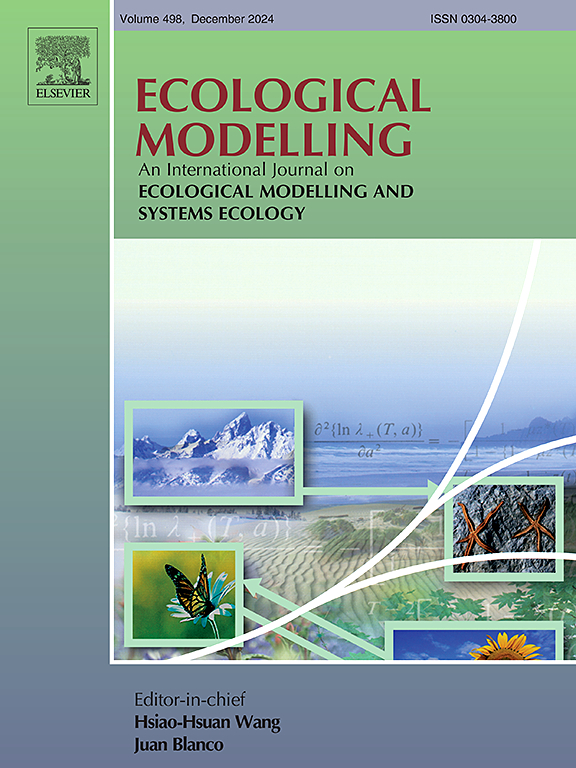Environmental system dynamics: Current development and applications
IF 2.6
3区 环境科学与生态学
Q2 ECOLOGY
引用次数: 0
Abstract
System Dynamics (SD) has emerged as a fundamental and powerful modeling methodology for understanding and simulating the behavior of both natural and social-economic systems. This review explores the historical development, key concepts, and broad applications of SD as a fundamental modeling approach. Tracing its evolution from the its inception since 1960s, the paper outlines the four major phases of SD's growth, from its initial conceptualization, through its methodological refinements, to its widespread application in ecosystems, and socio-economic systems in recent over the half century. The review highlights the development of SD communities across the globe, including the North American school, European clusters, and the growing body of work in China, and the progress in the global collaboration. We discuss and organize the foundational paired concepts of SD, including stock-flow relationships, the structure-behavior paradigm, the cause-effect process, and the loop-feedback paradigm. We summarize the SD modeling workflow protocol in the four stages, as conceptualization, visualization, quantification, and verification. It demonstrates good practices of SD modeling in various ecological contexts, spanning population, community, landscape, and macro-ecosystem levels, while emphasizing the method's adaptability and capacity for spatial modeling. Building on an extensive literature review and bibliometric analysis, the paper synthesizes key progress in SD modeling while offering insights into future perspectives and potential advancements. It concludes by reflecting on SD's ability to address multi-scale, multi-dimensional challenges and its compatibility with emerging novel approaches. Our goal is to bridge SD with contemporary ecological modeling practices by systematically reviewing the theoretical and practical advances of SD. This review provides insights for scholars and practitioners seeking to embed SD approach to the environmental and ecological systems simulation.

环境系统动力学:当前发展与应用
系统动力学(SD)已经成为理解和模拟自然和社会经济系统行为的一种基础和强大的建模方法。这篇综述探讨了SD作为一种基本建模方法的历史发展、关键概念和广泛应用。本文追溯了可持续发展自20世纪60年代以来的发展历程,概述了可持续发展发展的四个主要阶段,从最初的概念化,到方法论的完善,再到近半个多世纪在生态系统和社会经济系统中的广泛应用。该报告强调了全球可持续发展社区的发展,包括北美学校、欧洲集群和中国不断增长的工作,以及全球合作的进展。我们讨论并组织了可持续发展的基本配对概念,包括库存流动关系、结构-行为范式、因果过程和循环反馈范式。总结了SD建模工作流程协议的概念化、可视化、量化和验证四个阶段。展示了SD建模在不同生态环境下的良好实践,包括人口、社区、景观和宏观生态系统水平,同时强调了该方法的适应性和空间建模能力。基于广泛的文献综述和文献计量学分析,本文综合了SD建模的关键进展,同时提供了对未来前景和潜在进展的见解。最后,它反映了可持续发展应对多尺度、多维挑战的能力,以及它与新兴新方法的兼容性。我们的目标是通过系统地回顾可持续发展的理论和实践进展,将可持续发展与当代生态建模实践联系起来。这篇综述为寻求将可持续发展方法嵌入环境和生态系统模拟的学者和实践者提供了见解。
本文章由计算机程序翻译,如有差异,请以英文原文为准。
求助全文
约1分钟内获得全文
求助全文
来源期刊

Ecological Modelling
环境科学-生态学
CiteScore
5.60
自引率
6.50%
发文量
259
审稿时长
69 days
期刊介绍:
The journal is concerned with the use of mathematical models and systems analysis for the description of ecological processes and for the sustainable management of resources. Human activity and well-being are dependent on and integrated with the functioning of ecosystems and the services they provide. We aim to understand these basic ecosystem functions using mathematical and conceptual modelling, systems analysis, thermodynamics, computer simulations, and ecological theory. This leads to a preference for process-based models embedded in theory with explicit causative agents as opposed to strictly statistical or correlative descriptions. These modelling methods can be applied to a wide spectrum of issues ranging from basic ecology to human ecology to socio-ecological systems. The journal welcomes research articles, short communications, review articles, letters to the editor, book reviews, and other communications. The journal also supports the activities of the [International Society of Ecological Modelling (ISEM)](http://www.isemna.org/).
 求助内容:
求助内容: 应助结果提醒方式:
应助结果提醒方式:


